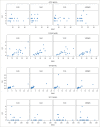Anterior Pituitary Hormones in Blood and Cerebrospinal Fluid of Patients in Neurocritical Care
- PMID: 35949361
- PMCID: PMC9354947
- DOI: 10.17925/EE.2022.18.1.71
Anterior Pituitary Hormones in Blood and Cerebrospinal Fluid of Patients in Neurocritical Care
Abstract
Background: Anterior pituitary hormones in blood follow a circadian rhythm, which may be influenced by various factors such as intracranial pathologies. In cerebrospinal fluid (CSF), pituitary hormones have been collected only selectively and circadian rhythm has not yet been investigated. This pilot study analysed diurnal variations of anterior pituitary hormones in patients in neurocritical care to determine whether circadian rhythmicity exists in these patients. Possible influences of intracranial pathologies were also investigated. Blood and CSF concentrations were assessed simultaneously to explore the value of blood concentrations as a surrogate parameter for CSF levels.
Methods: Blood and CSF samples of 20 non-sedated patients were collected at 06:00, noon, 18:00 and midnight, and analysed for adrenocorticotropic hormone (ACTH), cortisol, thyroid-stimulating hormone (TSH) and insulin-like growth factor-1 (IGF-1) concentrations at each of the four time points. ACTH and IGF-1 were measured by sandwich chemiluminescence immunoassay. Cortisol and TSH were measured by electrochemiluminescence immunoassay.
Results: Results showed inconsistent circadian rhythms. Less than 50% of the patients showed a circadian rhythmicity of ACTH, cortisol, TSH or IGF-1. Significance of diurnal variations was only present for blood concentrations of TSH. Correlations between blood and CSF concentrations were strong for cortisol and TSH.
Conclusions: CSF concentrations were only in the measurable range in some of the patients. No clear circadian rhythmicity could be identified, except for TSH in blood. Absence of significant diurnal variations could be explained by the underlying pathologies or disturbing influences of the intensive care unit. Blood concentrations of cortisol and TSH may be suitable surrogate parameters for CSF.
Keywords: Anterior pituitary hormones; cerebrospinal fluid; circadian rhythm; neurocritical care.
© Touch Medical Media 2022.
Conflict of interest statement
Disclosures: Henriette Beyer, Nicole Lange, Armin H Podtschaske, Jan Martin, Lucia Albers, Alexander von Werder, Jürgen Ruland, Gerhard Schneider, Bernhard Meyer, Simone M Kagerbauer and Jens Gempt have no financial or non-financial relationships or activities to declare in relation to this article.
Figures





Similar articles
-
Altered time structure of neuro-endocrine-immune system function in lung cancer patients.BMC Cancer. 2010 Jun 21;10:314. doi: 10.1186/1471-2407-10-314. BMC Cancer. 2010. PMID: 20565977 Free PMC article.
-
Neuro-endocrine correlations of hypothalamic-pituitary-thyroid axis in healthy humans.J Biol Regul Homeost Agents. 2011 Apr-Jun;25(2):249-57. J Biol Regul Homeost Agents. 2011. PMID: 21880214
-
Circadian secretory pattern of growth hormone, insulin-like growth factor type I, cortisol, adrenocorticotropic hormone, thyroid-stimulating hormone, and prolactin during HIV infection.AIDS Res Hum Retroviruses. 1997 Sep 20;13(14):1243-9. doi: 10.1089/aid.1997.13.1243. AIDS Res Hum Retroviruses. 1997. PMID: 9310292
-
[Biologic rhythms. Nyctemeral variation in man].Presse Med. 1999 May 1-8;28(17):936-41. Presse Med. 1999. PMID: 10360195 Review. French.
-
Chronobiology in endocrinology.Ann Ist Super Sanita. 1993;29(4):613-31. Ann Ist Super Sanita. 1993. PMID: 7985925 Review.
Cited by
-
The clinical impact of chronopharmacology on current medicine.Naunyn Schmiedebergs Arch Pharmacol. 2025 Jun;398(6):6179-6191. doi: 10.1007/s00210-025-03788-7. Epub 2025 Jan 10. Naunyn Schmiedebergs Arch Pharmacol. 2025. PMID: 39792169 Free PMC article. Review.
References
-
- Becker KL. Principles and practice of endocrinology and metabolism. Philadelphia: Lippincott Williams & Wilkins. 2001
-
- Winer LM, Shaw MA, Baumann G. Basal plasma growth hormone levels in man: New evidence for rhythmicity of growth hormone secretion. J Clin Endocrinol Metab. 1990;70:1678–86. - PubMed
-
- Engwall M, Fridh I, Johansson L. et al. Lighting, sleep and circadian rhythm: An intervention study in the intensive care unit. Intensive Crit Care Nurs. 2015;31:325–35. - PubMed
LinkOut - more resources
Full Text Sources
Miscellaneous
